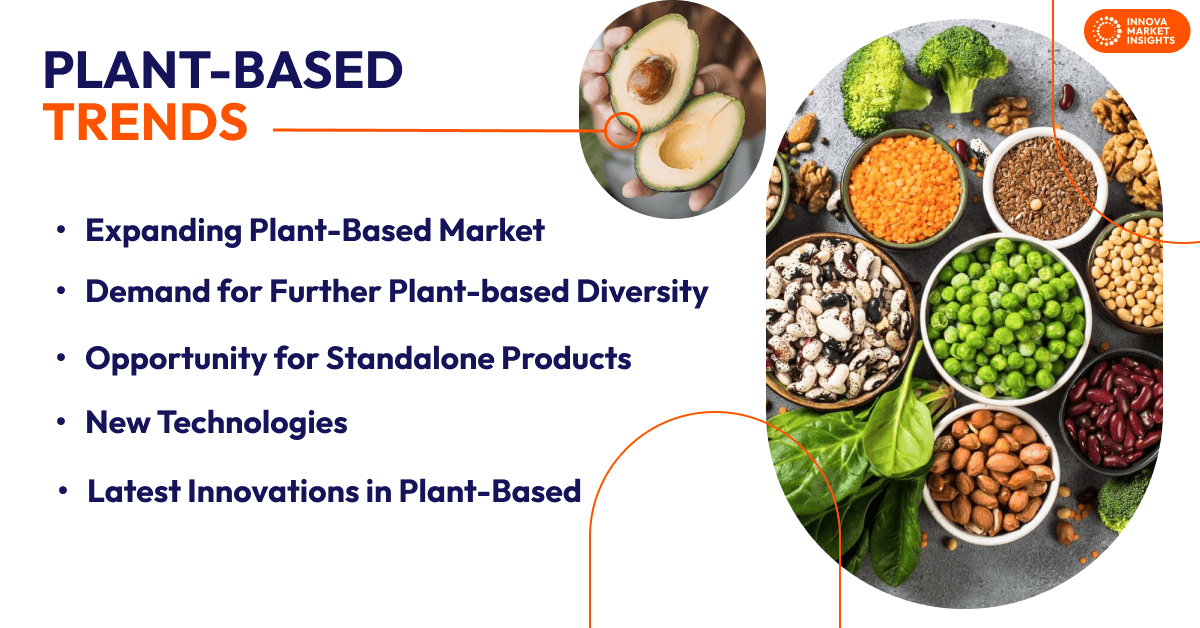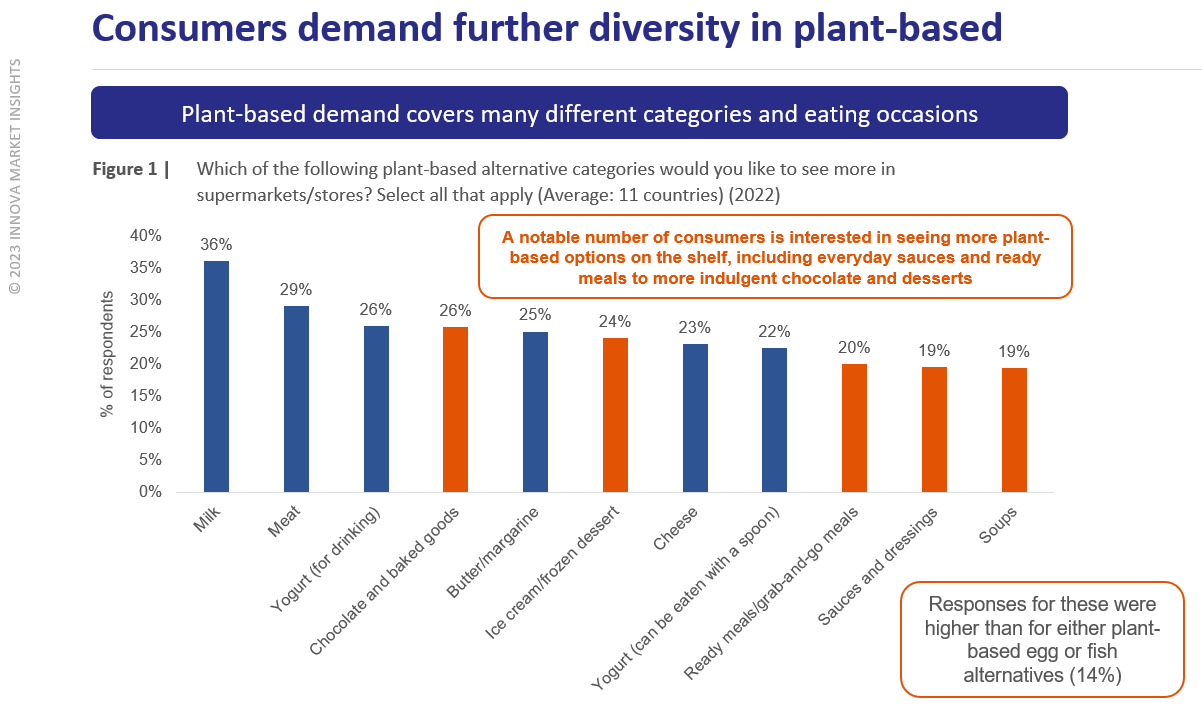What are the latest trends and opportunities in plant-based ingredients?
Dec 23, 2024Explore the latest trends and opportunities in the plant-based food sector, highlighting innovations in ingredients, consumer demand, and emerging technologies. Learn about global growth, protein trends, and the future of plant-based alternatives.
The plant-based revolution continues to reshape the food and beverage industry, presenting both exciting challenges and abundant opportunities. As consumer awareness of health, sustainability, and ethical concerns grows, the demand for innovative plant-based options is stronger than ever. This article explores the latest plant-based ingredient trends and opportunities, synthesizing insights from various market reports and analyses to provide a comprehensive overview.
Global Market Overview: The Rise of Plant-Based
The plant-based sector is experiencing significant global growth, driven by consumer demand for healthier and more sustainable food choices. Asia, in particular, has seen the fastest growth rate in food and beverage launches with a plant-based claim, showcasing a remarkable +85% CAGR between 2018 and 2022. This expansion isn't limited to a single region, with the Middle East, Africa, and Latin America also demonstrating substantial growth.
 Credit: www.innovamarketinsights.com
Credit: www.innovamarketinsights.com
This expansion is fueled by a diverse consumer base. While the number of vegans and vegetarians remains relatively stable, the rise of flexitarians—those who actively include plant-based meals in their diets—is a major factor in the growth of the plant-based market. Nearly 50% of consumers follow some form of dietary principle, with flexitarians, vegetarians, and vegans making up a significant portion of the consumer base. This trend is pushing the demand for greater variation and innovation in plant-based products.
Demand for Diversity and Innovation in Plant-Based
Consumers are increasingly seeking diversity in plant-based options, moving beyond basic meat and dairy replacements. While plant-based milk and meat alternatives remain significant categories, there is a growing demand for plant-based options across various occasions, including everyday sauces, ready meals, and even indulgent desserts. This desire for variety presents an opportunity for manufacturers to innovate and expand their product lines.
 Credit: www.innovamarketinsights.com
Credit: www.innovamarketinsights.com
Interestingly, while plant-based meat alternatives were initially conceived as direct replacements for animal-based meat, many consumers prefer whole vegetables and legumes as their first choice when replacing meat. This highlights a crucial opportunity for plant-based products to establish their own identity as a standalone sector rather than simply mimicking animal products.
New Technologies Driving Innovation
The desire for improved taste and texture is a major driver in the plant-based sector, with 44% of consumers wanting better flavor in plant-based products. New technologies are playing a crucial role in bringing nutrition and taste together.
- Fermentation: Fermentation is emerging as a key technology, enhancing plant-based products like non-dairy cheese and chocolate. For instance, companies like Planet A Foods are using fermentation to create cocoa-free chocolate.
- Cell-Based Technology: Innovation in cell-based technology is expanding possibilities beyond meat. This includes using plant and algae-sourced scaffolding, as well as 3D-printed scaffolding for cultivating meat alternatives.
- Microalgae Technology: Microalgae, grown in bioreactors, are proving to be a promising source of alternative protein, offering a highly nutritious and protein-packed option.
Protein Trends in Plant-Based Meat and Milk
Protein is a major focus for consumers, driving interest in plant-based protein sources. Global megatrends, as well as environmental and health concerns, are motivating consumers to explore plant-based options. Consumers perceive products with plant-based protein as healthy and natural, and a solid percentage has consumed plant-based milk or meat in the past year.
Plant-based protein ingredients are being used in various food and beverage categories, including ready meals, meat, fish, eggs, plant-based meat substitutes, and dairy alternatives. The strongest growth is seen in plant-based meat substitutes, spreads, dairy alternatives, and soups.
Popular Claims and Ingredients
The most common claims on plant-based protein product labels include protein, vegan, vegetarian, and plant-based. Halal claims are also gaining traction. Protein claims are more prevalent on plant-based products compared to conventional ones, followed by gluten-free claims. Vegan, vegetarian, and plant-based claims are increasing, often associated with clean label, sustainability, and lifestyle choices.
Soy protein, pea protein, and wheat protein are the most widely used plant-based protein ingredients, but other legumes are also emerging. These proteins are used in intact, isolated, hydrolyzed, or concentrated forms. Plant-based meat substitutes are increasingly incorporating plant-based protein, with growth outpacing overall meat substitutes.
Market Leaders and Future Trends
The plant-based market is led by plant-based meat and dairy substitutes. Subcategories like soy products, plant-based fish, and poultry alternatives are showing strong growth. Plant-based burgers, ground meat, and meatballs are experiencing more modest growth.
Dairy alternatives are also seeing increased penetration of plant-based proteins. A challenge in this sector is the relatively low protein content of many popular options like oat, coconut, and almond milk. Manufacturers are now focusing on improving the nutritional profiles of these products.
Consumer trends indicate a willingness to embrace new technologies for plant-based meat and dairy alternatives. The continued interest in better taste and nutrition presents significant opportunities for manufacturers.
Ingredient Suppliers and Plant-Based Food Trends
The rising demand for plant-based products is creating significant opportunities for food ingredient brands. Consumers are becoming increasingly knowledgeable about ingredients, seeking transparency and education about the components in their food. Ingredient brands should consider this when marketing to manufacturers, highlighting the source and benefits of their products.
Key Categories for Ingredient Suppliers
- Milk Alternatives: The market for milk alternatives is rapidly expanding, with non-soy options experiencing the fastest growth. This presents a significant opportunity for innovative plant-based ingredients. The joint venture between Kraft Heinz and TheNotCompany, Inc., which uses AI to identify plant-based combinations for milk alternatives, illustrates this trend.
- Frozen Foods: The frozen food aisle is seeing an increase in plant-based offerings, offering consumers convenience and ease of adding more plant-based foods into their diets. Ingredient brands can provide solutions for achieving desired taste profiles in frozen plant-based meals, snacks, and desserts.
- Snacks: The snack food category is experiencing growth in plant-based options, driven by vegan and vegetarian diets, as well as the trend of replacing meals with snacks. This opens up opportunities for meat alternative snacks, fruit and nut snacks, grain-based snacks, and plant-based snack bars.
The Future of Plant-Based: Overcoming Challenges
While the plant-based industry has seen tremendous growth, it faces some key challenges. One of the biggest is the perception of ultra-processing, which is leading to a consumer pushback against some plant-based alternatives. To address this, there is an increasing movement towards minimally processed products with simpler, more recognizable ingredients.
Key Strategies for Continued Success
- Clean Label: Industry stakeholders should focus on simplifying ingredients and leaning towards minimally processed options. Transparency in ingredients and manufacturing is essential for building consumer trust.
- Health Benefits: Brands need to highlight the health benefits of plant-based diets, emphasizing whole-food ingredients and minimizing unnecessary additives. Collaborating with nutritionists and health professionals can further support these claims.
- Hybrid Products: Hybrid products, which combine plant-based ingredients with some animal-derived products, are gaining popularity. This is a major shift, but one that is proving popular with consumers.
- Affordability: Price remains a significant barrier to plant-based adoption. However, the industry is working to address this, and some plant-based options are becoming more price-competitive with animal-based counterparts.
Emerging Trends and Opportunities
Several emerging trends will shape the latest plant-based ingredient trends and opportunities in the coming years:
- Plant-Based Seafood: Consumer interest in plant-based seafood is growing, driven by concerns about the environmental impact of commercial fishing.
- Functional Health: There is an increasing demand for products that tap into functional health, such as milk substitutes designed for athletic recovery.
- Diverse Protein Sources: Improved variety in plant-based protein sources is essential for sustained growth. Brands are exploring new types, formats, and sources of plant-based protein to meet consumer demand.
- Taste and Texture: Plant-based brands must focus on creating alternatives that successfully mimic the taste and texture of animal products.
- Fungi-Derived Protein: Fungi-derived protein is gaining traction due to its versatility, high protein content, and naturally fibrous textures. It also offers a sustainable and cost-effective production method.
- Hybrid Products: Combining plant-based ingredients with animal-derived products is becoming a key trend, offering opportunities to create products with optimal sensory and nutritional profiles.
- Food Service: The food service industry is increasingly adopting plant-based options, creating new opportunities for ingredient suppliers and plant-based brands.
- Budget-Friendly Options: As consumers become more price-conscious, there's a growing demand for affordable plant-based options, driving a trend towards budget-friendly flexitarianism.
Key Takeaways and Moving Forward
The plant-based industry is dynamic and continuously evolving. By addressing challenges such as price sensitivity and consumer perceptions around processing, and by embracing innovation in ingredients and production technologies, the sector is poised for continued growth. This is a time of great opportunity for brands that focus on quality, transparency, and a deeper understanding of consumer needs and preferences. The latest plant-based ingredient trends and opportunities are not just a fleeting phenomenon but a fundamental shift in how we approach food production and consumption.
The industry must continue to innovate and push the boundaries of what is possible, while also addressing the need for transparency and affordability. By doing so, the plant-based sector can continue to grow and contribute to a more sustainable and healthier future.
Jan 21, 2025
Explore the pros and cons of a plant-based diet, including health benefits, potential challenges, and tips for successful implementation. Learn about vegetarian, vegan, and flexitarian approaches.
Jan 20, 2025
Explore the latest research on plant-based diets and their powerful health benefits, including disease prevention, heart health, diabetes management, and cancer risk reduction.
Jan 16, 2025
Explore the nutritional landscape of processed fake meat, comparing them to traditional meat and whole plant foods. Learn about ingredients, health impacts, and making informed choices.